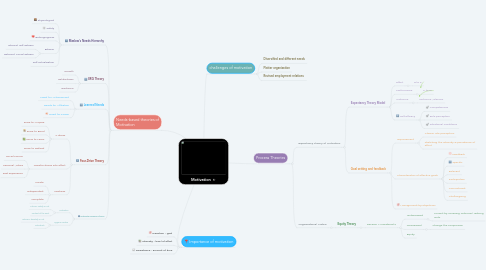
1. Importance of motivation
1.1. Direction - goal
1.2. Intensity - level of effort
1.3. Persistence - amount of time
2. Needs-based theories of Motivation
2.1. Maslow's Needs Hierarchy
2.1.1. Physiological
2.1.2. Safety
2.1.3. Belongingness
2.1.4. Esteem
2.1.4.1. Internal, self-esteem
2.1.4.2. External, Social esteem
2.1.5. Self-actualization
2.2. ERG Theory
2.2.1. Growth
2.2.2. Relatedness
2.2.3. Existence
2.3. Learned Needs
2.3.1. Need for Achievement
2.3.2. Needs for Affiliation
2.3.3. Need for Power
2.4. Four-Drive Theory
2.4.1. 4 drives
2.4.1.1. Drive to Acquire
2.4.1.2. Drive to Bond
2.4.1.3. Drive to Learn
2.4.1.4. Drive to Defend
2.4.2. Transfer drives into effort
2.4.2.1. Social Norms
2.4.2.2. Personal Values
2.4.2.3. Past experience
2.4.3. Features
2.4.3.1. Innate
2.4.3.2. independent
2.4.3.3. complete
2.5. Motivator-Hygiene Theory
2.5.1. Motivators
2.5.1.1. Intrinsic, satisfy or not
2.5.1.2. Content of the work
2.5.2. Hygiene Factors
2.5.2.1. Extrinsic, dissatisfy or not
2.5.2.2. Individuals
3. challenges of motivation
3.1. Diversified and different needs
3.2. Flatter organization
3.3. Revised employment relations
4. Process Theories
4.1. Expectancy Theory of Motivation
4.1.1. Expectancy Theory Model
4.1.1.1. Effort
4.1.1.1.1. E to P
4.1.1.2. Performance
4.1.1.2.1. P to O
4.1.1.3. Outcome
4.1.1.3.1. Outcome Valences
4.1.1.4. Self-efficacy
4.1.1.4.1. Competencies
4.1.1.4.2. Role perception
4.1.1.4.3. Situational conditions
4.1.2. Goal setting and feedback
4.1.2.1. Improvement
4.1.2.1.1. Clearer role perception
4.1.2.1.2. stretching the intensity & persistence of effort
4.1.2.2. Characteristics of effective goals
4.1.2.2.1. Feedback
4.1.2.2.2. Specific
4.1.2.2.3. Relevant
4.1.2.2.4. Participation
4.1.2.2.5. Commitment
4.1.2.2.6. Challenginng
4.1.2.3. Management-by-objectives
4.2. Organizational Justice
4.2.1. Equity Theory
4.2.1.1. Receive = Investment?
4.2.1.1.1. Underreward
4.2.1.1.2. Overreward
4.2.1.1.3. Equity

